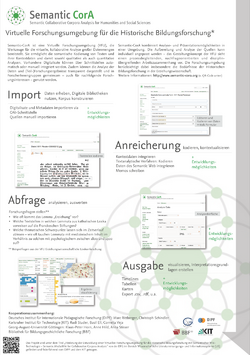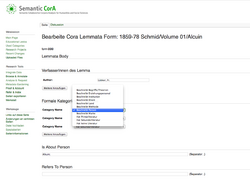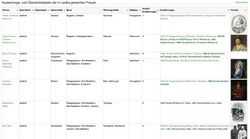Description Use Case VFU-ELF: Unterschied zwischen den Versionen
Anna (Diskussion | Beiträge) |
|||
| (13 dazwischenliegende Versionen von 3 Benutzern werden nicht angezeigt) | |||
| Zeile 1: | Zeile 1: | ||
| − | = | + | [[File:Poster_Semantic_CorA_small_German.png|right|thumb|250px|Research cycle with Semantic CorA (Poster, 2013)]] |
| + | Below, we describe what the Use Cases are about (see also the [[Technical_Description_Use_Case_VFU-ELF|technical description]]), and briefly introduce the VRE (Virtual Research Environment for Lexicon Studies in Educational Science) to enable an insight into concrete research practice (see Stisser/Hild/Ell/Schindler 2013). | ||
| + | =Research interest= | ||
| − | == | + | ==Reference works in pedagogy and educational science== |
| − | + | Pedagogical reference works bear a particularly high research value given that we can assume knowledge that has been included in a reference work represents the “mainstream‘ of a research discipline (regarding the relevance of reference works for the discipline, see e.g.. Lenzen/Rost 1999; Herzog 2005; Brachmann 2008; Prodöhl 2011). Hence, it is suitable for presenting the “cognitive gestalt” of the discipline’s development (Herzog 2005: 676). Accordingly, researchers working on associated doctoral projects will explore trend discontinuities, appropriations and delimitations of boundaries of disciplinary knowledge, focusing on the central term of “Erziehung’ (education/care) in educational science reference books from 1895 until 1989 – thus a period of time when educational science in Germany was institutionalised, established, specialised and diversified as a research discipline taught at universities, (project “Erziehung in Fachlexika der Erziehungswissenschaft von 1895 bis 1989“, Anna Stisser). On the other hand, the project “’Helden’ und ‚Denker’ der Pädagogik im Spiegel ihrer Fachlexika von 1774 bis 1942” by Anne Hild willl investigate the people portrayed in reference works. Two questions are at its core: who is mentioned and thus characterised as being important for the discipline? And: How are these persons described respectively construed? | |
| − | + | The VRE platform is jointly used for both projects, based on Semantic CorA. In total, 83 reference books (lexicons) were integrated into the VRE. These are currently being assessed. | |
| − | == | + | =Working with the VRE= |
| + | This VRE (VFU ELF) is the first virtual research environment realised by Semantic CorA. Below, we describe some possible research approaches exemplarily run within this virtual research site. | ||
| + | [[File:Startseite VFUELF.jpg|right|thumb|250px| VFU ELF homepage]] | ||
| − | + | == Transfer== | |
| + | An OAI interface enables automated transfer of digitised reference works and their bibliographical metadata from [http://bbf.dipf.de/digitale-bbf/scripta-paedagogica-online/digitalisierte-nachschlagewerke Scripta Paedagogica Online (BBF)], including digitised files (image files), so that all relationships among data are retained ("is author of", "is volume of", "is lemma in", ...) (cf. [[Technical_Description_Use_Case_VFU-ELF|technical description]]). In addition, bibliographical information (Lexicon, volume, editor, author, title of lemma, pages , ...) together with selected digitised lexicon objects is manually integrated via a specialised form [[Semantic_CorA_Extensions#OfflineImportLexicon|(Tool: OfflineImportLexicon)]]. Without exception, all thus transferred data can be edited and queried on the VRE. | ||
| − | + | == Categorisation== | |
| − | + | Even at the level of lemma keywords, allocations can be made, e.g. all lemmata describing persons can be marked as such via a form. The research process enables query of all lemmata denoting a person. Categorisation is operable by intuition. New categories can be developed and inserted any time if necessary for a research process. | |
| − | + | [[File:Formular_Lemmabeschreibung.png|right|thumb|250px| Categorisation of Lemmata]] | |
| − | + | == Coding == | |
| − | |||
| + | In the VRE, an annotation tool (cf. [[Semantic_CorA_Extensions|Semantic Image Annotator]]) enables qualitative data analysis. The annotation tool permits text coding. It is thus possible to look at the different codes, compare and visualize them. | ||
| − | + | The image illustrates how a relevant passage in a text regarding a person, e.g. Pestalozzi, is marked: | |
| − | == | + | [[File:Kodierung SIA.jpeg|right|thumb|250px|Kodierung einzelner Wörter oder Passagen in |
| + | == Cumulated query== | ||
| − | + | Queries allow for clear presentations of data in tables, thus they can be prepared for transfer, e.g. into Excel. To launch a query, users can either write their own queries or use the analysis tool (see screenshots on the right hand side). | |
| + | [[File:Frauentabelle.jpg|right|thumb|250px|Query for women cited in reference work, with portraits – table]] | ||
| + | [[File:Analysetool.jpg|right|thumb|250px| Search mask of the tool]] | ||
| − | |||
| − | = | + | |
| + | =References= | ||
*Brachmann, Jens (2008): Der pädagogische Diskurs der Sattelzeit. Eine Kommunikationsgeschichte. Bad Heilbrunn. | *Brachmann, Jens (2008): Der pädagogische Diskurs der Sattelzeit. Eine Kommunikationsgeschichte. Bad Heilbrunn. | ||
| Zeile 32: | Zeile 40: | ||
*Lenzen, Dieter/Rost, Friedrich (1999): Die Fachlexikographie der Pädagogik/Erziehungswissenschaft. In: Hoffmann/Kalverkämper/Wiegand, 2. Halbband. Berlin u.a., S. 2013-2036. | *Lenzen, Dieter/Rost, Friedrich (1999): Die Fachlexikographie der Pädagogik/Erziehungswissenschaft. In: Hoffmann/Kalverkämper/Wiegand, 2. Halbband. Berlin u.a., S. 2013-2036. | ||
*Prodöhl, Ines (2011): Die Politik des Wissens : allgemeine deutsche Enzyklopädien zwischen 1928 und 1956. Berlin. | *Prodöhl, Ines (2011): Die Politik des Wissens : allgemeine deutsche Enzyklopädien zwischen 1928 und 1956. Berlin. | ||
| + | *Stisser, Anna/Hild, Anne/Ell, Basil/Schindler, Christoph (2013): Neue Forschungswerkzeuge in der Historischen Bildungsforschung. Die virtuelle Forschungsumgebung SMW-CorA für die kollaborative Analyse und Auswertung umfangreicher digitalisierter Quellen. In: Jahrbuch für Historische Bildungsforschung 19, S. 305-325. | ||
Aktuelle Version vom 25. November 2014, 15:38 Uhr
Below, we describe what the Use Cases are about (see also the technical description), and briefly introduce the VRE (Virtual Research Environment for Lexicon Studies in Educational Science) to enable an insight into concrete research practice (see Stisser/Hild/Ell/Schindler 2013).
Research interest
Reference works in pedagogy and educational science
Pedagogical reference works bear a particularly high research value given that we can assume knowledge that has been included in a reference work represents the “mainstream‘ of a research discipline (regarding the relevance of reference works for the discipline, see e.g.. Lenzen/Rost 1999; Herzog 2005; Brachmann 2008; Prodöhl 2011). Hence, it is suitable for presenting the “cognitive gestalt” of the discipline’s development (Herzog 2005: 676). Accordingly, researchers working on associated doctoral projects will explore trend discontinuities, appropriations and delimitations of boundaries of disciplinary knowledge, focusing on the central term of “Erziehung’ (education/care) in educational science reference books from 1895 until 1989 – thus a period of time when educational science in Germany was institutionalised, established, specialised and diversified as a research discipline taught at universities, (project “Erziehung in Fachlexika der Erziehungswissenschaft von 1895 bis 1989“, Anna Stisser). On the other hand, the project “’Helden’ und ‚Denker’ der Pädagogik im Spiegel ihrer Fachlexika von 1774 bis 1942” by Anne Hild willl investigate the people portrayed in reference works. Two questions are at its core: who is mentioned and thus characterised as being important for the discipline? And: How are these persons described respectively construed? The VRE platform is jointly used for both projects, based on Semantic CorA. In total, 83 reference books (lexicons) were integrated into the VRE. These are currently being assessed.
Working with the VRE
This VRE (VFU ELF) is the first virtual research environment realised by Semantic CorA. Below, we describe some possible research approaches exemplarily run within this virtual research site.
Transfer
An OAI interface enables automated transfer of digitised reference works and their bibliographical metadata from Scripta Paedagogica Online (BBF), including digitised files (image files), so that all relationships among data are retained ("is author of", "is volume of", "is lemma in", ...) (cf. technical description). In addition, bibliographical information (Lexicon, volume, editor, author, title of lemma, pages , ...) together with selected digitised lexicon objects is manually integrated via a specialised form (Tool: OfflineImportLexicon). Without exception, all thus transferred data can be edited and queried on the VRE.
Categorisation
Even at the level of lemma keywords, allocations can be made, e.g. all lemmata describing persons can be marked as such via a form. The research process enables query of all lemmata denoting a person. Categorisation is operable by intuition. New categories can be developed and inserted any time if necessary for a research process.
Coding
In the VRE, an annotation tool (cf. Semantic Image Annotator) enables qualitative data analysis. The annotation tool permits text coding. It is thus possible to look at the different codes, compare and visualize them.
The image illustrates how a relevant passage in a text regarding a person, e.g. Pestalozzi, is marked: [[File:Kodierung SIA.jpeg|right|thumb|250px|Kodierung einzelner Wörter oder Passagen in
Cumulated query
Queries allow for clear presentations of data in tables, thus they can be prepared for transfer, e.g. into Excel. To launch a query, users can either write their own queries or use the analysis tool (see screenshots on the right hand side).
References
- Brachmann, Jens (2008): Der pädagogische Diskurs der Sattelzeit. Eine Kommunikationsgeschichte. Bad Heilbrunn.
- Herzog, Walter (2005): Pädagogik und Psychologie im Wörterbuch. Zur Normalität der Erziehungswissenschaft. In: Zeitschrift für Pädagogik 51, S. 673-693.
- Lenzen, Dieter/Rost, Friedrich (1999): Die Fachlexikographie der Pädagogik/Erziehungswissenschaft. In: Hoffmann/Kalverkämper/Wiegand, 2. Halbband. Berlin u.a., S. 2013-2036.
- Prodöhl, Ines (2011): Die Politik des Wissens : allgemeine deutsche Enzyklopädien zwischen 1928 und 1956. Berlin.
- Stisser, Anna/Hild, Anne/Ell, Basil/Schindler, Christoph (2013): Neue Forschungswerkzeuge in der Historischen Bildungsforschung. Die virtuelle Forschungsumgebung SMW-CorA für die kollaborative Analyse und Auswertung umfangreicher digitalisierter Quellen. In: Jahrbuch für Historische Bildungsforschung 19, S. 305-325.





